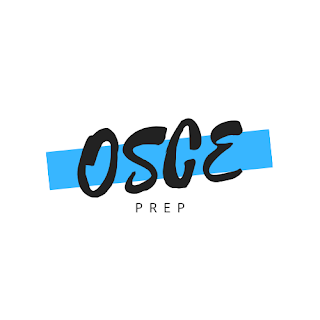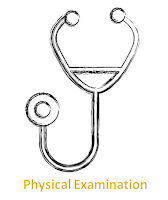Past Year Topics for USM OSCE - 2019 - Part I
Hi all, in this post I am going to share the topics they have on year 2019 for Examination for Provisional Registration-/EPR. (the year I took my exams😁Thank God I passed)
** EPR is a special exam where International Medical Graduates must take to get full licence to work in Malaysia.
So I will provide more details on how the questions were asked and what I experienced specifically for the USM December 2019 session. However I won't be able to recall the questions fully word by word, but will try my best to explain what was being asked.
The other session for 2019 are USM-Feb and IMU-July will be posted in another post.
Reminder:
You have 1 minute to read the questions outside the room and once the bell rang, you have 9 minutes to finish the station. the second bell will ring, and you will have to move to the next station quickly to read the next question.
USM (December 2019)
Emergency medicine
1. Patient involve in motor vehicle accident, access the patient and do immediate management
- Emergency management of Pneumothorax
- Name all the equipment needed in ED (we have to name the equipments shown on the table)
- explain the safe triangle position in detail
- perform the procedure from the safe triangle
Orthopedics
2. Patient involve in motor vehicle accident and have problem walking, you are require to do a lower limb PE
- identify short limb gait (at least that is what I think it is) ** real patient walking
- so I proceed with full lower limb physical examination and LLD(Limb Length Discrepancy) diagnosis
- Physical examination necessary to identify
LLD
3. Hip X-ray with a problem, patient short history provided
- Describe the X-ray, give a diagnosis and explain your further management
- identify all structures shown in the picture and explain their functions.
P/S: remember to check patient name and date
Internal medicine
4. Patient with chest pain and SOB, take the history and explain further management if needed
- history taking and I suspect its AMI
5. Interpret chest X-ray and give diagnosis with treatment + physical examination of the chest
- Tips: there is a mass in the chest x-ray
P/S: treatment plan must be specific***
Surgery
6. Patient present with mass at inguinal area, diagnose and focus physical examination
- Inguinal Hernia - after history taking, ask for permission to do examination
- physical examination is done on the manikin. (you can refer to
this to understand the scoring)
** The examiner asked the differences of direct and indirect hernia physical examinations and their respective treatments.
7. Pneumoperitoneum - X- ray interpretation and management plan
- management is specific
Tips: if you plan to have iv fluid, what do you want to do? (is it fluid bolus? how much you want to give? how long you plan to administer the fluid? etc.)
Pediatrics
8. Growth Chart interpretation
- scenario given was about short stature. (explain the cause, QOL, management)
Tips: calm the child down first so they can cooperate
9. Lumbar Puncture Consent from Parents
- get the consent is the aim. make sure you explain all about lumbar puncture from the cause to the treatment values.
- reassure the patient
OBGYN
10. Bimanual Examination
- there is a huge mass in the manikin.
- explain your examination specifically on inspection and palpation,
- the examiner will ask for your diagnosis and your management plan for the patient
11. Patient complain is stomach pain and discomfort (a little aggitated)
- After history taking, i suspect its a Placenta Abruption case.
- the examiner asked for our diagnosis
- present your case from history taking
remember to include: Gestational age calculation, GPO - all OBGYn necessary history
- treatment plan
*P/S: I finish this station when the bell rang for us to leave the room. We only have 9 minutes to do all the above, make sure you manage your time well.
Anesthesiology
12. Patient need to prep for surgery, as a junior doctor apply adequate oxygenation before anesthesiologist arrive.
- full airway assessment and use the Bag valve mask (if you observe well, you will see it lying on the table beside the manikin) -explain the indication and possible complications.
*P/S: - the procedure was easy as i did a lot during my internship in china (finish smoothly in a few minutes), but the examiner asked a lot of questions and fully utilized the 9 minutes. Be ready to answer a lot of questions and make sure you know what and why you do what you have done.
Psychiatry
13. The patient is very sad and depressed. If you have good observation, you will see a plaster on her wrist.
- The patient has history of suicide, so after accessing the patient and confirm it is related to suicide, I used the suicide risk assessment to confirm the diagnosis.
- the examiner will ask how you come out with your diagnosis, luckily i still remember the specific components for the assessment. (the examiner asked how I get the score)
ENT
14. ASOM
- acute suppurative otitis media
* I am very thankful to be able to work as a clinic assistant for an ENT doctor for almost a year.
Really grateful I know how to use the equipment, give diagnosis, explain the cause, complication and management to the patient very quickly and specifically. I spend a lot of time sitting outside the station to wait for the next bell to ring.😄Thank you Doctor Koay!
Radiology
15. Two CT was showed
- I suspect it's a CT with Epidural hematoma and subdural hematoma
- we are require to explain the CT in detail to support our diagnosis
*P/S: this is the only station I don't know if what i did is right or wrong. because he is not satisfied with the answer i gave, and when I asked the other students, they say the same thing..
Until now I still don't know what the doctor showed us, because I forgot how the CT looks like... (sad)
Community Medicine
16. Consultation on
family planning
- asking for pregnancy advice and how to have a healthy
*P/S: the patient has diabetes after minutes of asking... So I have to quickly brief her the pros and cons on the complication of pregnancy while having an uncontrolled diabetes situation.
If you have more questions can leave a comment below, I will try to reply as soon as possible.
Good luck!
 HI again, this is the PART II for past year questions on 2019. The Part I post only explains the past year questions that I took during December 2019 in Hospital USM December.
HI again, this is the PART II for past year questions on 2019. The Part I post only explains the past year questions that I took during December 2019 in Hospital USM December.












